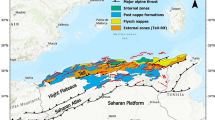Abstract
A homogenous earthquake catalog is a basic input for seismic hazard estimation, and other seismicity studies. The preparation of a homogenous earthquake catalog for a seismic region needs regressed relations for conversion of different magnitudes types, e.g. m b , M s , to the unified moment magnitude M w. In case of small data sets for any seismic region, it is not possible to have reliable region specific conversion relations and alternatively appropriate global regression relations for the required magnitude ranges and focal depths can be utilized. In this study, we collected global events magnitude data from ISC, NEIC and GCMT databases for the period 1976 to May, 2007. Data for mb magnitudes for 3,48,423 events for ISC and 2,38,525 events for NEIC, M s magnitudes for 81,974 events from ISC and 16,019 events for NEIC along with 27,229 M w events data from GCMT has been considered. An epicentral plot for M w events considered in this study is also shown. M s determinations by ISC and NEIC, have been verified to be equivalent. Orthogonal Standard Regression (OSR) relations have been obtained between M s and M w for focal depths (h < 70 km) in the magnitude ranges 3.0 ≤ M s ≤ 6.1 and 6.2 ≤ M s ≤ 8.4, and for focal depths 70 km ≤ h ≤ 643 km in the magnitude range 3.3 ≤ M s ≤ 7.2. Standard and Inverted Standard Regression plots are also shown along with OSR to ascertain the validation of orthogonal regression for M s magnitudes. The OSR relations have smaller uncertainty compared to SR and ISR relations for M s conversions. ISR relations between m b and M w have been obtained for magnitude ranges 2.9 ≤ m b ≤ 6.5, for ISC events and 3.8 ≤ m b ≤ 6.5 for NEIC events. The regression relations derived in this study based on global data are useful empirical relations to develop homogenous earthquake catalogs in the absence of regional regression relations, as the events catalog for most seismic regions are heterogeneous in magnitude types.




Similar content being viewed by others
References
Carrol RJ, Ruppert D (1996) The use and misuse of orthogonal regression in linear errors-in-variables models. Am Stat 95(N1):58–74
Castellaro S, Bormann P (2007) Performance of different regression procedures on the magnitude conversion problem. Bull Seismol Soc Am 97:1167–1175
Castellaro S, Mulargia F, Kagan YY (2006) Regression problems for magnitudes. Geophys J Int 165:913–930
Das R, Wason HR (2010) Comment on A homogeneous and complete earthquake catalog for Northeast India and the adjoining region. Seismol Res Lett 81:232–234
Draper NR, Smith H (1998) Applied regression analysis, 3rd edn. Wiley, New York
Fuller WA (1987) Measurement error models. Wiley, New York
Giardini D (1984) Systematic analysis of deep seismicity: 200 centroid-moment tensor solutions for earthquakes between 1977 and 1980. Geophys J R Astr Soc 77:883–914
Gutenberg B (1945a) Amplitudes of P, PP and S and magnitudes of shallow earthquakes. Bull Seismol Soc Am 35:57–69
Gutenberg B (1945b) Magnitude determination for deep focus earthquakes. Bull Seismol Soc Am 35:117–130
Gutenberg B, Richter CF (1956) Magnitude and energy earthquakes. Ann Geofis 9:1–15
Hanks TC, Kanamori H (1979) A moment magnitude scale. J Geophys Res 84:2350–2438
Heaton TH, Tajima F, Mori AW (1986) Estimating ground motions using recorded accelerograms. Surv Geophys 8:25–83
Joshi GC, Sharma ML (2008) Uncertainties in the estimation of M max. J Earth Syst Sci 117(S2):671–682
Kagan YY (2003) Accuracy of modern global earthquake catalogs. Phys Earth Planet Inter 135:173–209
Kanamori H (1977) The energy release in great earthquakes. J Geophys Res 82:2981–2987
Karnik V (1973) Magnitude differences. Pure Appl Geophys 103(II):362–369
Kendall MG, Stuart A (1979) The advanced theory of statistics, vol 2, 4th edn. Griffin, London
Kiratzi AA, Karakaisis GF, Papadimitriou EE, Papazachos BC (1985) Seismic source parameter relations for earthquakes in Greece. Pageoph 123:27–41
Madansky A (1959) The fitting of straight lines when both variables are subject to error. Am Statist As J 54:173–205
Nuttli OW (1983) Average seismic source-parameter relations for mid-plate earthquakes. Bull Seismol Soc Am 73:519–535
Nuttli OW (1985) Average seismic source-parameter relations for plate-margin earthquakes. Tectonophysics 118:161–174
Papazachos BC, Kiratzi AA, Karakostas BG (1997) Toward a homogencous moment-magnitude determination for earthquakes in Greece and the surrounding area. Bull Seismol Soc Am 87:474–483
Richter C (1935) An instrumental earthquake magnitude scale. Bull Seismol Soc Am B11(1):2302
Ristau J (2009) Comparison of magnitude estimates for New Zealand earthquakes: moment magnitude, local magnitude, and teleseismic body-wave magnitude. Bull Seismol Soc Am 99:1841–1852
Scordilis EM (2006) Empirical global relations converting M S and m b to moment magnitude. J Seism 10:225–236
Stromeyer D, Grünthal G, Wahlström R (2004) Chi-square regression for seismic strength parameter relation, and their uncertainties, with application to an m w based earthquake catalogue for central, northern and northwestern Europe. J Seism 8:143–153
Thingbaijam KKS, Nath SK, Yadav A, Raj A, Walling MY, Mohanty WK (2008) Recent seismicity in Northeast India and its adjoining region. J Seism 12:107–123
Utsu T (2002) Relationships between magnitude scales. In: Lee WHK, Kanamori H, Jennings PC, Kisslinger C (eds) International handbook of earthquake and engineering seismology part A. Academic Press, Amsterdam, pp 733–746
Vanek J, Zatopek A, Karnik V, Kondorskaya NV, Savarensky EF, Riznichenko YV, Soloviev SL, Shebalin NV (1962) Standardization of magnitude scales. Bull Acad Sci USSR Geophys Ser 57:108–111
Author information
Authors and Affiliations
Corresponding author
Rights and permissions
About this article
Cite this article
Das, R., Wason, H.R. & Sharma, M.L. Global regression relations for conversion of surface wave and body wave magnitudes to moment magnitude. Nat Hazards 59, 801–810 (2011). https://doi.org/10.1007/s11069-011-9796-6
Received:
Accepted:
Published:
Issue Date:
DOI: https://doi.org/10.1007/s11069-011-9796-6




